This site is supported by our readers. We may earn a commission, at no cost to you, if you purchase through links.
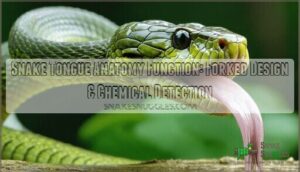
When you see that tongue flicking out, it’s collecting airborne molecules on each tip—creating a stereo scent system that builds 3D chemical maps of the environment.
The bifurcated design lets snakes sample different air spaces simultaneously, then transfer these particles to their vomeronasal organ for processing.
This specialized system can flick up to 150 times per hour, detecting prey trails, mates’ pheromones, and potential threats with remarkable precision.
The snake tongue anatomy function basically allows these reptiles to "taste" their world in ways we can barely imagine.
This sophisticated sensory system holds secrets that might surprise you about how snakes navigate their complex environments.
Table Of Contents
- Key Takeaways
- Snake Tongue Anatomy: Forked Design and Structure
- Chemical Detection: Snake Tongue’s Primary Function
- Tongue Flicking: Mechanism and Purpose
- Vomeronasal Organ: Snake’s Specialized Olfactory System
- 3D Smelling: Spatial Awareness Through Tongue
- Prey Location: Tongue’s Role in Hunting
- Mating Behavior: Pheromone Detection by Tongue
- Environmental Navigation: Tongue as Sensory Guide
- Evolutionary Advantages of Forked Tongue Design
- Frequently Asked Questions (FAQs)
- Why do snakes have tongues?
- What happens when a snake sticks out its tongue?
- What is a snake tongue?
- Can snakes taste with their tongues?
- Why do snakes have a split tongue?
- What are snake tongue muscles?
- What is the function of a snake’s tongue?
- Can snakes survive without a tongue?
- Why do snakes have Y-shaped tongues?
- What do snakes use their forked tongue for?
- Conclusion
Key Takeaways
- Your snake’s forked tongue creates a stereo chemical detection system – each tip samples different air spaces simultaneously, building 3D scent maps that pinpoint prey, mates, and threats with remarkable precision.
- You’re watching nature’s most advanced chemical sensor in action – the tongue can flick up to 150 times per hour, collecting airborne molecules and transferring them to the vomeronasal organ for processing concentrations as low as parts per billion.
- Your snake uses its tongue like a biological GPS system – the bifurcated design generates air vortices that concentrate scent particles, allowing snakes to follow chemical trails with 95% accuracy even in complete darkness.
- You’ll find this system compensates for limited vision – the tongue-driven chemoreception transforms molecular information into survival decisions, making snakes master hunters despite seeming disadvantages through sophisticated environmental navigation.
Snake Tongue Anatomy: Forked Design and Structure
You’ll find that a snake’s tongue isn’t just split for show – it’s a masterpiece of evolutionary engineering designed for chemical detection.
The forked design creates two independent sampling points that work together like a biological GPS system, collecting scent molecules from different areas to build a three-dimensional map of the world around them.
Nature’s chemical GPS transforms simple scent detection into three-dimensional environmental mapping through dual-tipped precision sampling.
Bifurcated Tongue Tips
The bifurcated tips of a snake tongue work like nature’s chemical GPS system. You’ll notice each tine operates independently, creating air vortices that boost scent collection up to 100 times more effectively than single tongues.
These flexible tips, covered in specialized tip keratin, extend through the rostral groove without opening the mouth. Snakes use this ability for directional scent detection, allowing them to locate prey and mates.
- Tine flexibility allows independent movement for sampling different spatial points simultaneously
- Independent movement enables stereo chemical detection, comparing left versus right odor concentrations
- Air vortices generated by tongue oscillation concentrate scent molecules for enhanced particle capture
This forked tongue design transforms your average snake tongue anatomy into a sophisticated sensory organ that maps chemical landscapes in three dimensions, giving snakes their legendary tracking abilities.
Muscular Composition
Two muscle types power your snake’s lightning-fast tongue.
Fast-twitch fibers deliver those explosive flicks you see—up to 15 times per second during active hunting.
Slow-twitch fibers handle sustained movements and precise muscle control for delicate scent sampling.
This fiber combination creates incredible flick speed while maintaining accuracy.
The snake tongue anatomy relies on these specialized muscle fibers working together, allowing perfect tongue mechanics for chemical detection through the rostral groove.
Tongue Sheath Location and Function
You’ll find the tongue’s protective home tucked safely in the snake’s lower jaw.
This tongue sheath acts like a personal moisture chamber, keeping the delicate organ hydrated and ready for action.
When it’s time to sample the air, muscular control shoots the tongue through the rostral groove – a clever lip notch that lets snakes taste without opening their mouths.
This sheath protection system keeps the snake tongue anatomy functioning perfectly, ensuring ideal snake tongue mechanics for chemical detection missions.
This allows snakes to have enhanced chemical detection, giving them an evolutionary advantage.
Sensory Papillae Distribution
Your snake’s sensory papillae aren’t randomly scattered—they’re strategically positioned.
Most cluster along tooth rows and oral mucosa rather than the tongue surface itself. This papillae density creates specialized zones where different receptor types detect chemical and mechanical signals.
When your snake flicks its tongue, these microscopic sensors capture particles with incredible chemical sensitivity. The forked design maximizes sampling area, giving snakes their 3D smelling superpower—an evolutionary advantage that turns hunting into precision targeting.
Snakes also possess specialized infrared receptors that help them locate warm-blooded prey.
Chemical Detection: Snake Tongue’s Primary Function
Chemical detection serves as your snake’s primary survival tool, transforming their forked tongues into sophisticated chemical laboratories.
When you observe a snake tongue flicking, you’re witnessing scent particle capture in action – the tongue collects airborne molecules that reveal everything about their environment.
The captured particles transfer directly to the Jacobson’s organ (vomeronasal organ) located in the mouth’s roof. This specialized structure processes chemical signals with incredible precision, detecting concentrations as low as parts per billion.
Through chemoreception, snakes perform chemical gradient analysis, creating detailed maps of their surroundings.
This system enables remarkable 3D smelling capabilities that put human noses to shame:
- Prey tracking becomes effortless – following chemical trails with 95% accuracy
- Predator detection happens instantly through scent recognition
- Mate location relies on pheromone identification across vast distances
- Food source discovery occurs even in complete darkness
- Territory navigation uses chemical landmarks like GPS coordinates.
The snake tongue fundamentally functions as a living chemical sensor, converting molecular information into survival decisions. This chemoreception system compensates for limited vision, making snakes master hunters despite seeming disadvantages. It’s nature’s most elegant scent tracking solution.
Tongue Flicking: Mechanism and Purpose
When you watch a snake’s tongue dart in and out, you’re seeing one of nature’s most efficient chemical detection systems in action.
The rapid flicking motion creates tiny air vortices that concentrate scent molecules, allowing the forked tips to sample up to 100 times more chemical information than a single flick would capture, which is a remarkable example of efficient detection.
Frequency and Duration of Flicks
When observing a snake’s tongue flicking, you’ll witness behavior that shifts dramatically based on context.
Resting snakes flick only 1-2 times per minute, but this Flick Rate jumps to 10-20 flicks during active hunting.
Several Flick Rate Factors control this sensory organ’s rhythm:
- Environmental Influence from temperature and humidity changes
- Prey Distance triggering increased sampling frequency
- Individual Variation between species and body sizes
- Flicking Purpose whether exploring, hunting, or detecting threats
Each flick lasts mere tenths of a second, yet snakes can produce 6-7 rapid samples in one-third of a second during intense chemoreception.
This snake behavior optimizes chemical detection while conserving energy.
Air Vortex Creation
Picture tiny tornadoes spinning off a snake’s flickering tongue.
Each rapid flick generates powerful air vortices that act like microscopic vacuum cleaners, drawing in airborne particles from multiple directions.
This flicking aerodynamics creates concentrated scent plumes, boosting particle capture efficiency dramatically.
The vortex strength varies with tongue speed, while sophisticated airflow dynamics funnel olfactory cues directly to sensitive tongue tips.
It’s nature’s ingenious solution for 3D smelling through controlled air circulation, utilizing the unique properties of the snake’s tongue to enhance its sensing capabilities.
Particle Collection Process
Through air vortexes, your snake’s forked tongue acts like a sophisticated molecular collector.
Each flick creates tiny whirlwinds that trap airborne particles and chemical signals onto the moist tongue surface.
This scent adhesion process enables stereo smelling – the two fork tips sample different chemical gradients simultaneously.
The collected particles then transfer to the vomeronasal organ (Jacobson’s organ) for processing, creating detailed environmental maps.
Energy Efficiency in Tongue Movement
A snake’s tongue movement showcases remarkable flick optimization through its aerodynamic design. The slender, forked structure minimizes metabolic cost while maximizing chemical sampling effectiveness.
This muscle efficiency allows snakes to gather environmental data with minimal exertion.
Here’s how snake tongue mechanics work:
- Muscle composition combines fast-twitch fibers for rapid deployment with slow-twitch fibers for sustained tongue activity
- Streamlined shape reduces air resistance, making each flick more energy-efficient
- Tongue mechanics enable 3-5 flicks per second without fatigue
This tongue function represents nature’s perfect balance between performance and energy conservation.
Vomeronasal Organ: Snake’s Specialized Olfactory System
You’ll find this remarkable organ tucked into the roof of your snake’s mouth, where it acts like a sophisticated chemical laboratory.
When the forked tongue delivers scent particles to this specialized structure, it processes the information and sends detailed chemical messages directly to the brain for instant analysis.
Location in Snake’s Mouth
When you peek inside a snake’s mouth, you’ll discover something amazing.
The vomeronasal organ sits snugly in the mouth roof, tucked behind two small openings called vomeronasal ducts.
This hidden chemical lab connects directly to the palatal contact area where the snake tongue delivers its samples.
Here’s how the tongue sheath and rostral groove work together:
Tongue flicks
Tongue sheath retracts
The vomeronasal access points act like tiny chemical laboratories.
Snake tongue structure perfectly matches this setup – when the forked tips retract, they slide right into these openings.
This snake tongue adaptation transforms simple air-flicking into sophisticated chemical sensing that puts bloodhounds to shame.
Neural Connections to Brain
Think of this neural network as the snake tongue’s communication highway to the brain.
The vomeronasal organ sends chemical data through dedicated vomeronasal pathways directly to specialized brain regions.
Olfactory bulb activity processes these signals, while brain signal interpretation transforms raw sensory data processing into actionable information.
This Jacobsons organ creates instant behavioral responses, turning tongue flicks into survival decisions.
Your sensory organ works like nature’s fastest internet connection.
Sensitivity to Chemical Stimuli
Your snake’s vomeronasal organ boasts incredible receptor density – thousands of sensory cells packed into fluid-filled chambers.
Detection thresholds reach parts per billion, letting you sample chemical stimuli with remarkable precision.
This olfactory system processes different molecule types through specialized neural processing pathways.
Environmental factors like humidity affect performance, but your snake tongue still delivers samples for exceptional sensory perception.
The organ’s chemical specificity helps distinguish between prey scents, predator warnings, and mate pheromones with surgical accuracy.
Evolutionary Development
Understanding how Tongues Notch evolved reveals nature’s amazing Genetic Basis for Limbless Adaptation.
Snake tongue evolution shows Convergent Evolution – monitor lizards developed similar forked designs independently.
This snake tongue evolutionary history demonstrates Sensory Refinement over millions of years.
Here’s how snake tongue sensory functions developed:
- Ancestral beginnings: Simple nasal sensory cells transformed into specialized snake tongue chemical sensing organs
- Structural evolution: Tongue bifurcation increased gradually, enhancing detection capabilities through snake tongue comparative studies
- Neural integration: Brain pathways developed to process complex chemical information efficiently
3D Smelling: Spatial Awareness Through Tongue
You’ll discover that snakes use their forked tongues like a chemical GPS system, creating a three-dimensional map of scents around them.
This stereo smelling ability lets them pinpoint exactly where odors come from, much like how your ears help you locate sounds in space.
Stereo Olfaction Technique
When you observe a snake’s stereo olfaction, you’re witnessing nature’s GPS system in action.
Each fork of the snake tongue performs bilateral sampling, collecting chemical signals from separate air pockets.
The vomeronasal organ processes this data through sensory integration, creating chemical mapping that rivals any navigation app.
This directional accuracy through gradient interpretation transforms simple tongue flicks into precise prey detection coordinates, making every slither a calculated move.
Chemical Gradient Detection
Your snake tongue works like a chemical compass, comparing scent concentrations between its two tines.
Each fork samples different air pockets, creating chemical gradients that map odor intensity. This tine independence gives snakes incredible chemosensory acuity for environmental mapping.
The receptor sensitivity helps pinpoint prey detection sources with pinpoint accuracy. Your vomeronasal organ processes this gradient interpretation, turning scent differences into a roadmap for survival.
This allows for directional scent tracking, giving them a distinct advantage.
Directional Sensing Capabilities
When you watch a snake’s forked tongue in action, you’re seeing stereo chemoreception at work.
Each tine operates independently, sampling different chemical concentrations simultaneously.
The snake’s brain performs gradient interpretation, comparing left versus right chemical signals to pinpoint the scent source location.
This tine independence creates precise chemical mapping, allowing directional sensing that turns faint chemical gradients into actionable navigation data.
It’s like having twin radar systems working together for 3D smelling precision.
Comparison With Other Sensory Systems
Unlike your vision vs. smell dependence, snakes master stereo chemoreception through their snake tongue and vomeronasal organ.
While mammals rely on airborne scents and birds lack functional vomeronasal systems, snakes sample non-volatile chemicals with precision.
They can’t detect sounds like you, but their touch and vibration sensitivity plus chemical gradients create unmatched animal olfaction abilities that surpass traditional sensory organ limitations.
Prey Location: Tongue’s Role in Hunting
When you’re hunting, your forked tongue becomes a precision tracking device that can follow prey trails with remarkable accuracy.
This chemical detection system lets you discriminate between different scent types and activate feeding responses while avoiding dangerous predators, utilizing your forked tongue as a key component in this process, with remarkable accuracy in tracking.
Trail Following Behavior
When you’re tracking prey, your snake tongue works like a molecular detective.
Each flick samples chemical trails left behind, creating a detailed map of where dinner went.
The forked design compares scent trail accuracy between left and right sides, helping you stay on course.
Environmental factors like humidity and wind affect chemical cue persistence, but your sensory organ adapts brilliantly.
Substrate influence matters too—smooth surfaces hold fewer molecules than rough terrain.
This predatory tracking system turns pheromone detection into an art form, making trail following incredibly precise.
Specialized tools can even aid in snake scent collection.
Scent Discrimination Abilities
A snake’s chemical detective work rivals any forensic lab.
Their snake tongue functions as a sophisticated sensory organ, collecting scent molecules for precise scent discrimination.
Through chemical detection, snakes achieve remarkable prey specificity and individual recognition.
- Prey specificity – Distinguishes between different species’ chemical signatures
- Predator scents – Identifies threatening chemicals to avoid danger
- Mate selection – Detects pheromones for reproductive success
- Chemical mimicry – Recognizes deceptive scents in the environment
This olfactory system processes information faster than you can blink!
Predator Avoidance Strategies
Beyond scent discrimination, your snake’s forked tongue becomes a chemical alarm system for predator avoidance.
Through environmental sensing, snakes detect danger pheromones and territorial markers left by threats. Evasive Maneuvers kick in when chemical detection reveals predator presence nearby.
Alarm Signals from other prey species get picked up, triggering Defensive Posturing. Some species even use Chemical Camouflage and Mimicry Tactics, masking their scent signatures.
These sensory abilities transform the tongue into nature’s early warning system. The vomeronasal organ processes these vital chemical signals.
Feeding Response Activation
Beyond dodging predators, your snake’s tongue becomes a sophisticated trigger system for feeding behavior.
When chemical cues reach the vomeronasal organ, they activate prey recognition patterns that enhance strike accuracy.
This feeding response initiates the swallowing reflex and serves as a digestion trigger.
The snake tongue’s chemical detection directly influences post-meal behavior, creating a seamless shift from prey location to successful feeding through precise chemical cues interpretation.
Mating Behavior: Pheromone Detection by Tongue
Your tongue becomes a sophisticated chemical detective when you’re searching for a mate, capable of detecting sex-specific pheromones that reveal potential partners from remarkable distances.
This remarkable organ transforms courtship into a precise chemical dance, where each flick samples airborne molecules that determine reproductive success and timing throughout the breeding season.
Sex-specific Chemical Cues
You encounter a chemical dating service when snakes use pheromone detection for mate recognition.
Female snakes release sex-specific molecules that males collect through tongue flicking.
This chemical communication enables sexual selection by allowing snakes to identify compatible partners and assess reproductive readiness.
The forked design maximizes pheromone reception, ensuring reproductive isolation between species while facilitating successful mating behavior through precise molecular messaging.
Courtship Rituals and Tongue Use
During mating season, males become chemical detectives.
They’ll rapidly flick their tongues—sometimes fifteen times per second—to track female pheromones across impressive distances.
This tongue flicking creates tiny air currents that capture chemical messages floating in the air.
Through pheromone detection, males can distinguish between receptive females and rivals.
Their courtship rituals involve following scent trails like a bloodhound, using chemical communication to assess potential mates before making their move.
Reproductive Success and Tongue Function
The snake tongue operates like nature’s ultimate matchmaking service, helping these reptiles find their perfect partners through sophisticated chemical communication.
Your understanding of reproductive success hinges on how effectively male snakes can detect and follow pheromone trails left by receptive females.
Males with longer, more deeply-forked tongues show enhanced mate recognition abilities, detecting female-produced pheromones with remarkable precision.
These chemical signals aren’t just random scents – they’re complex blends that reveal species identity, reproductive status, and even female body condition.
The vomeronasal system processes these airborne love letters, allowing males to:
- Track pheromone gradients with 85-95% accuracy in laboratory settings
- Distinguish between receptive and non-receptive females through hormonal cues
- Redirect energy efficiently by avoiding already-mated females.
This tongue-driven courtship behavior directly impacts genetic influence on future generations, with successful males passing on their superior chemosensory abilities to offspring.
Seasonal Variations in Tongue Activity
The snake’s sensory tool operates like a biological radar system throughout the year.
During Mating Season, tongue activity peaks as males frantically sample pheromone trails.
Temperature Influence and Prey Availability drive these seasonal variations in snake anatomy function.
Environmental Changes trigger hormonal shifts affecting tongue behavior, while Hibernation Effects nearly shut down this critical sensory system during winter months.
| Season | Activity Level | Environmental Trigger |
|---|---|---|
| Spring | Maximum | Breeding pheromones |
| Summer | Moderate | Prey detection |
Environmental Navigation: Tongue as Sensory Guide
When you watch a snake navigate its world, you’re seeing one of nature’s most sophisticated chemical navigation systems in action.
The forked tongue transforms every environment into a detailed scent map, helping snakes locate water sources, identify territorial boundaries, and find the perfect temperature spots for survival.
Habitat Exploration Techniques
Your snake tongue acts like nature’s chemical compass when exploring new territory.
These remarkable sensory tools perform terrain analysis by collecting ground-level particles, revealing what creatures passed through recently.
Through chemical gradient mapping, snakes detect concentration differences that guide their environmental navigation.
Watch how habitat exploration unfolds:
- Environmental sampling of air currents for distant prey
- Scent trail following to track movement patterns
- Chemical detection of water sources and shelter
- Prey tracking through layered scent signatures
This sophisticated snake tongue system transforms every flick into environmental intelligence gathering.
To further understand, consider snake habitat products for exploration.
Thermoregulation and Tongue Use
While snakes use their tongue flicking for chemical detection, they don’t directly sense temperature through their tongues.
Instead, tongue-mediated environmental adaptation helps snakes locate ideal thermal zones for thermoregulation.
By sampling air and surfaces, snake tongue activity guides them toward warm basking spots or cool refuges.
This snake thermoregulation strategy combines chemical cues with behavioral choices, supporting thermal preferences essential for survival.
This is possible because the vomeronasal organ processes these chemical signals.
Water Source Location
When you’re traversing scorching deserts, your snake tongue becomes nature’s most sophisticated water detector.
Through humidity detection, desert snakes sample moisture gradients in the air, creating detailed maps of water trail locations.
Their forked design excels at chemical detection of vapor concentrations, guiding them toward precious hydration needs.
This environmental adaptation helps locate everything from underground springs to morning dew collection sites, ensuring survival in harsh landscapes.
Territory Marking Detection
Your snake’s forked snake tongue acts like nature’s own surveillance system, constantly sampling chemical signatures that mark territorial boundaries.
This sophisticated sensory tool excels at Boundary Identification through chemical detection, picking up on Pheromone Signaling left by other serpents. Marking Chemical Analysis helps determine territory ownership and potential threats, while Scent Trail Following reveals recent activity patterns for effective Territory Defense.
Snakes also use specialized products for artificial territory marking.
Here’s how territory marking detection works:
- Chemical fingerprinting – Each snake species leaves unique pheromone signatures that identify the territory holder
- Freshness dating – Tongue sampling determines how recently another snake passed through the area
- Threat assessment – Different chemical concentrations indicate whether the territory owner is nearby or absent
- Safe passage routes – Snake senses map unmarked corridors for avoiding territorial conflicts
- Boundary respect – Chemical gradients show exactly where one territory ends and another begins
Evolutionary Advantages of Forked Tongue Design
The forked tongue’s evolutionary journey spans over 100 million years, transforming from simple notched tongues in early snake ancestors into today’s sophisticated dual-tipped chemical detection system.
You’ll find that this remarkable adaptation gives snakes a survival advantage that’s hard to beat—imagine having a built-in GPS that works through smell alone, helping them hunt prey and avoid danger with incredible precision.
Adaptation to Various Ecosystems
Nature’s chemical compass tells an incredible survival story.
Snake tongues have mastered the art of Desert Adaptations, Aquatic Environments, and Forest Habitats through millions of years of evolution.
These snake tongue adaptations showcase remarkable flexibility across diverse ecological niches.
Consider how environmental adaptations work in practice:
- Desert species increase flicking rates to catch sparse chemical signals in arid conditions
- Aquatic snakes sample water-borne molecules while swimming or hunting fish
- Forest dwellers navigate dense canopy layers using enhanced particle detection
- Mountain species detect Prey Variations despite thin air and cold temperatures
- Burrowing snakes sense chemical trails in complete darkness underground
Climate Influences shape these snake tongue environmental interactions perfectly.
Hot environments demand rapid sampling, while cold climates require sensitive detection systems.
This versatility explains why snakes thrive in nearly every habitat on Earth.
Comparative Anatomy With Other Reptiles
You’ll find snake tongues stand out dramatically when compared to their reptile relatives.
While lizard tongues are simpler and turtle tongues remain stubby, snake tongues have evolved into sophisticated chemical sensors.
| Reptile Type | Tongue Features |
|---|---|
| Snake Tongue | Deeply forked, highly flexible |
| Lizard Tongue | Slightly notched, less sensitive |
| Turtle Tongues | Short, thick, limited mobility |
| Crocodile Tongues | Fixed, minimal sensory function |
| Monitor Lizards | Forked but less developed |
This evolutionary divergence gave snakes superior sensory differences in comparative anatomy.
Their tongue morphology represents millions of years of refinement, creating what’s basically a chemical GPS system that outperforms other lizardlike reptiles in environmental detection.
Genetic Basis of Tongue Morphology
Comparing snake tongues to their lizard cousins reveals fascinating genetic differences.
You’ll find that Hox genes play starring roles in tongue development, with specific mutations creating the forked design. Gene expression patterns show how evolutionary genomics shaped this incredible tool over millions of years.
Here’s what makes snake tongue genetic basis so remarkable:
- WNT signaling pathway genes – These create the perfect fork structure that makes your jaw drop
- Vomeronasal receptor gene families – Expanded versions give snakes their chemical superpowers
- Developmental transcription factors – They guide the tongue’s unique bifurcated architecture like master architects
- Collagen and elastin genes – Under positive selection to keep tongues flexible yet durable
The genetic basis of snake tongue morphology involves over 500 genes undergoing positive selection.
These mutation effects directly impact tongue structure, making snakes the ultimate chemical detectives of the reptile world.
Future Evolutionary Trends in Snake Tongues
Snake tongues will continue evolving as climate adaptation and novel environments shape their development.
Genetic drift and evolutionary pressures may produce longer, more sensitive tongues for enhanced sensory specialization.
Future snake evolution trends suggest increased branching patterns, while genetic mutations could create species-specific adaptations.
Artificial selection through habitat changes will drive snake tongue future research, revealing how these chemical detectors optimize survival strategies in changing ecosystems.
Frequently Asked Questions (FAQs)
Why do snakes have tongues?
You’ve got a chemical detection system that’s like having a built-in GPS for smells.
That forked tongue collects scent particles from the air and delivers them to a special organ in their mouth, letting them "taste" their environment in 3D to find prey and navigate.
What happens when a snake sticks out its tongue?
When you see a snake stick out its tongue, it’s collecting chemical particles from the air and ground.
The forked tongue traps scent molecules, then transfers them to the vomeronasal organ in its mouth for processing.
This creates a 3D chemical map of the environment.
What is a snake tongue?
At 15 flicks per second, you’re watching nature’s chemical detective work.
A snake’s tongue is a forked sensory organ that collects airborne molecules, delivering them to the vomeronasal organ for processing scent information.
Can snakes taste with their tongues?
No, you can’t taste with your tongue like snakes do.
Their forked tongues don’t have taste buds – they collect chemical particles from air and ground, then transfer them to a special organ in their mouth roof called the vomeronasal organ for processing.
Why do snakes have a split tongue?
Snakes evolved split tongues to enhance their chemical detection abilities.
Each fork tip collects scent particles independently, creating a "stereo smell" system that helps them precisely locate prey, mates, and threats in three-dimensional space.
What are snake tongue muscles?
Like tiny springs coiled for action, your snake’s tongue muscles contain both fast-twitch and slow-twitch fibers that power those lightning-quick flicks and sustained movements for chemical detection.
What is the function of a snake’s tongue?
A snake’s forked tongue acts as a sophisticated chemical detector, collecting airborne molecules and transferring them to the vomeronasal organ for processing.
This creates "3D smelling" capabilities that help locate prey.
Can snakes survive without a tongue?
Unfortunately, you’d quickly discover serpents struggle severely without their sophisticated sampling system. Tongue-less snakes can’t detect chemical gradients, making hunting, navigation, and mate-finding nearly impossible, though they might survive temporarily.
Why do snakes have Y-shaped tongues?
That Y-shaped fork isn’t just for show—you’re looking at nature’s chemical GPS system.
Each tine samples air independently, creating stereo smell that lets snakes pinpoint scent sources in 3D space for hunting and navigation.
What do snakes use their forked tongue for?
Ever wonder how snakes navigate without eyes like yours?
They use their forked tongues as chemical detectors, collecting scent particles from air and ground to track prey, find mates, and avoid predators through sophisticated 3D smelling, utilizing their tongues to detect chemical signals.
Conclusion
Remarkably refined reptilian receptors reveal nature’s most sophisticated sensory system.
Your snake’s forked tongue represents millions of years of evolutionary perfection in chemical detection. The snake tongue anatomy function creates a three-dimensional scent landscape that guides every aspect of survival.
From hunting prey to finding mates, this bifurcated biological tool transforms invisible chemical trails into essential survival information.
Next time you watch that tongue flick, you’re witnessing one of nature’s most elegant solutions to environmental navigation, a result of millions of years of evolution, leading to evolutionary perfection in chemical detection.
- https://theconversation.com/explainer-why-do-snakes-flick-their-tongues-29935
- https://museumsvictoria.com.au/article/8-myths-about-snakes/
- https://nhpbs.org/natureworks/nwep3d.htm
- https://www.smithsonianmag.com/science-nature/how-snakes-use-their-senses-180970944/
- https://en.wikipedia.org/wiki/Vomeronasal_organ




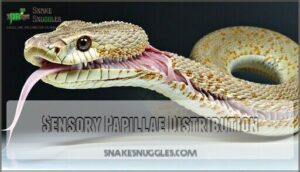


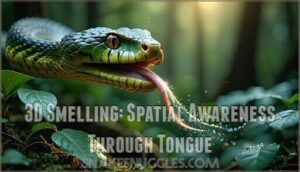

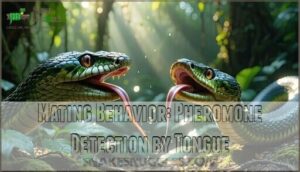






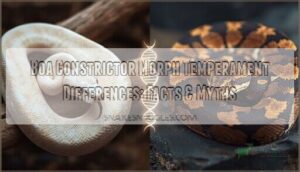

Romulus Whitaker
October 10, 2025 at 03:54 AM
Excellent! My question/comment is, we often find the 'shedded' tongue tips in the water dish of captive snakes and we wonder if, like snakes shed skins, eye caps, teeth and fangs they are also shedding the covering of the tongue to keep it sensitive, since the surface must 'wear down' when it is flicking it on the substrate. Comments?